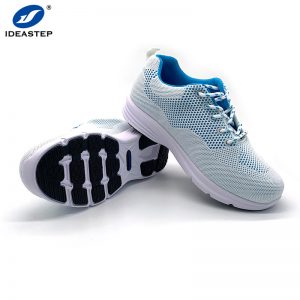There is a distinct difference in the way the shoes are built, and knowing about it can help you avoid harm.
Walking is one of the most basic exercises you can do for your health, but choosing the right shoe to do it in can be a challenge. With so many choices, it’s tempting to get caught up in the glitz and glam—or to become so overwhelmed that you only wear one pair of shoes for everything.
“There is clearly a difference between walking shoes and running shoes,” says Chanel Perkins, D.P.M., a board-certified podiatrist at UTMB Health Internal Medicine in Houston.
“I had an event years ago where I donned a pair of running shoes on a day-long vacation to an amusement park and walked miles and miles,” she recalls. “By the end of the day, my feet were unhappy since my shoes provided so little support.” We’ve all been there: hurting feet from wearing the incorrect shoe.
On October 2, join the Prevention Virtual Walk! Register for free and walk a 5K anywhere. We are excited to walk “with” you!
What you should know about running vs. walking shoes, because there is a distinction.
Because the needs of a walker differ from those of a runner, the standard design of walking and running shoes differs. Experts recommend paying close attention to the weight, cushioning, and flexibility of your shoes.
Shoe weight
The weight of a shoe has an immediate effect on the wearer’s pace. Running shoes are often lighter than other types of shoes, making fast movements easier. Walking shoes, on the other hand, are often heavier, which aids in maintaining stability while walking. Running shoes, on the other hand, support faster motions, whereas walking shoes support a slower, more consistent, and steady pace.
Cushioning
Cushioning is an important design feature to consider when choosing between a running and walking shoe, according to experts. Both walkers and runners want to be at ease during their chosen exercise. For most walkers, this means having strong foot support for an extended period of time, whereas runners are more concerned with protecting their foot’s foundation as it hits the ground repeatedly.
Most running shoes have more cushioning in the forefoot and heel than walking shoes. That extra padding is unnecessary for walkers. “Runners may find it more comfortable to have greater cushion support as their running stride has more impact. When it comes to walking and the consistent heel strike, a more flexible shoe is more important,” says Maricris Lapaix, a certified personal trainer and nutrition consultant.
Flexibility
Runners and walkers require good shoe flexibility, but where it is located is crucial. The ability of a shoe to move with you is determined by its flexibility. The midfoot or arch of most running shoes is more flexible, which supports the runner’s constant strike at the midfoot or ball of their foot. Walkers require high arch flexibility since they push off with their toes.
In other words, according to Marion Yau, BsC, a podiatrist at Harley Street Medical Clinic in the United Kingdom, running shoes lack the flexibility in the shoe sole that walkers require for constant heel-to-toe movement. Walkers who lack arch flexibility risk stretching and inflaming the plantar fascia ligament, which can be quite painful.
Is it ever OK to walk in a running shoe?
While it isn’t ideal, it does make sense for some. The most significant factor is your general comfort, which differs from person to person. So, if you’ve discovered that walking in running shoes is beneficial to you, be sure to take the required steps to avoid injury.
“Make sure the shoes fit well and are comfortable,” advises Yau, who is a podiatrist. According to Casey Ann Pidich, D.P.M., popularly known as Dr. Glass Slipper, a podiatrist at Park Avenue Podiatry Care in New York, adding arch support to your running shoes will help avoid arch pain that develops over time while you walk.
Dr. Pidich, on the other hand, argues that wearing minimalist sneakers for walking should be avoided at all costs. She argues that these types of running shoes don’t provide nearly enough shock absorption for walking. “Forefoot strikers may benefit from Vibram Five Fingers or Merrell Vapor Gloves, but they will not provide enough support for basic walking,” she explains.
Whether you choose a running or walking shoe, pay attention to how you feel during your stroll to make sure it meets your needs. Remember to replace your walking or running shoes every 300-400 miles or four to six months, according to Dr. Perkins. Your shoes, like car tires, need to be replaced after a certain number of miles of wear and tear.
Do you require assistance in locating the ideal pair? Here are some of our favorite walking shoes:

